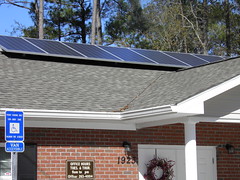Among regions, the South has the largest number of clean economy jobs though the West has the largest share relative to its population. Seven of the 21 states with at least 50,000 clean economy jobs are in the South. Among states, California has the highest number of clean jobs but Alaska and Oregon have the most per worker.
 A per-county map is included, on which you can see North Carolina
and Atlanta, but nothing in south Georgia.
Let’s put Lowndes County on the clean energy map!
A per-county map is included, on which you can see North Carolina
and Atlanta, but nothing in south Georgia.
Let’s put Lowndes County on the clean energy map!
The gigaom article recommends:
To help boost the clean energy economy even more, the Brookings report suggests that Congress could pass a national clean energy standard, put a price on carbon, use the government as a chief customer of cleantech goods (Obama has been strong on this), find more ways to help proven clean technologies pass the so-called Valley of Death, as well as increase funding for basic science and early-stage high risk projects (like the Department of Energy’s ARPA-E program).
 That’s good stuff, but we don’t have to wait for the feds.
The
Wiregrass Solar plant
sets a precedent that we can build on.
That plant is readily
expandable to an additional megawatt.
That’s good stuff, but we don’t have to wait for the feds.
The
Wiregrass Solar plant
sets a precedent that we can build on.
That plant is readily
expandable to an additional megawatt.
 It can also be used to attract financing for other projects,
projects that can use local labor, for example
solar electricity and hot water like the example in Quitman.
It can also be used to attract financing for other projects,
projects that can use local labor, for example
solar electricity and hot water like the example in Quitman.
Lots of places have forged ahead into real clean energy on their own, such as Birmingham, England and San Antonio.
Sure, we’re not nearly as big as those places, or so local “leaders” remind me. So let’s find some projects of our scale that we can do, and let’s do them! A real leader might say, as Mayor Julian Castro of San Antonio did, that renewable energy is
That opportunity is right here in south Georgia, waiting for us to seize it.“…the nexus between sustainability and job creation. Every now and then, perhaps once in a generation, there presents itself a moment, an opportunity, for those cities that are willing to seize it, to truly benefit the region for generations to come.”
-jsq








